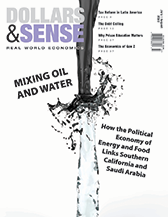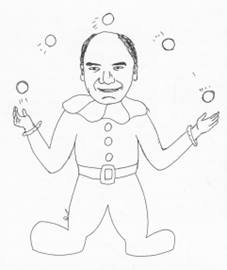True Affirmative Action
Give Those Without Privilege a Fighting Chance to Get a Piece of Privilege
This article is from Dollars & Sense: Real World Economics, available at http://www.dollarsandsense.org

This is an online-only article.
Subscribe Now
at a 30% discount.
Among successful people who start from nothing, some take all the credit themselves and despise those left behind. Witness that member of the Horatio Alger Club, Justice Clarence Thomas. Others acknowledge the help they received and devote themselves to giving back. Witness investigative journalist Greg Palast, scourge of vote-suppressing politicians. As Palast writes in a recent article republished at the Dollars & Sense website, “Confessions of an Affirmative Action Baby,” Stanford University took a chance on him, a kid from a poor LA neighborhood, speaking only Spanglish and unable to spell.
Or witness my husband, Thomas Haines. When Tom was four, a judge placed him in an orphanage, “by reason of the insanity of the mother.” Fortunately, it was a very special orphanage: the Graham School, founded in 1806 by Isabella Graham and Elizabeth Hamilton, the widow of Alexander Hamilton. Today, the Graham School is a major New York City social services and foster care agency. Tom has served on its board since 2010.
After Graham, Tom attended City College of New York, where he soon became a professor of chemistry. City College was established in 1847 to provide an excellent free education to all the residents of the City. In 1970, Tom took that mission one step further. He designed a successful program to bring poor minority and immigrant students into a new medical school. This is the story, as told in his autobiography, A Curious Life: From Rebel Orphan to Innovative Scientist.
Part of Tom’s job was to advise City College students who were preparing to go to medical school:
I soon realized that the existing system discriminated against low-income students, especially blacks and other minorities…The conventional route to an M.D. in the US and Canada requires four years of college, followed by four years of medical school. Premed undergraduates must take a year each of biology, physics, basic chemistry, and organic chemistry. The first two years of medical school curriculum consist of classroom courses in basic science. This route to an M.D. has two serious drawbacks. First, undergraduate premed courses either duplicate portions of the first years of medical school or are irrelevant. Second, entry to medical school is ferociously competitive, and medical school tuition is prohibitively expensive in all nations other than the United States and Canada, students begin medical school as high school graduates.
In 1970, City College appointed a new president, Dr. Robert E. Marshak. Marshak, a prominent physicist, came to City College from the University of Rochester, bent on developing a strong urban university. “This college was founded to help the socially disadvantaged, and that’s what I wanted to do,” he often explained. Tom approached Marshak and found him immediately receptive to what they called a biomedical program at City College. “Marshak had a vision of a medical school that would train minority students as physicians who would then return to serve their communities.”
After extensive exploration, Tom discovered a plan for a six-year medical program for undergraduates. The plan, developed for the Johns Hopkins School of Medicine, had been rejected by faculty who felt it would be demeaning to teach undergraduates.
In a two-year mad scramble, Tom and Marshak developed the program, hired faculty, raised the money, and admitted the first class in the fall of 1973. The program was named The Sophie Davis School of Biomedical Education after a major funder.
The program had the following key features: As in medical schools outside the US and Canada, incoming freshmen took a year-long course in Gross Human Anatomy, including cadaver dissections. As Tom emphasizes, this would put all students on the same footing regardless of how good or limited their academic backgrounds. The program also included a four-year interdisciplinary series of courses on Health Medicine and Society. Given the reality that many students would be ill-prepared, the program provided intensive remedial support. The students would all have to pass national medical school boards, putting them on the same level as graduates of other medical schools. After four years, the students were “matched” to internship positions for the two clinical years in a consortium of conventional medical schools, including New York University, Mount Sinai, and Howard University. In those days, City College had no tuition.
The first key to the program was recruiting applicants. For this, the program advertised heavily in schools with a large population of poor, minority, and immigrant students. It also established an outreach program called Bridge to Medicine, to motivate high school students to consider medicine. The second key was selecting the actual students. As Tom recounts in his autobiography,
The admissions procedure had to avoid bias and quotas. If we wanted to get more minorities into medical school, we had to find a way of choosing them without ethnic or racial prejudice.
When I set out to establish an admissions committee, I had no students and no faculty. For interviewers, I leaned on the City College faculty and upon former CCNY students who were now in medical school. Our new fifteen-member Admissions Committee had no prior experience with medical students, let alone with such a unique program. I divided the committee into five three-member subcommittees. For each subcommittee, I enlisted one student, one regular science faculty member, and one person who had contacts within the black or other ethnic communities. Those three people together would not only make up one-fifth of the Admissions Committee, but they would also be an “interviewing committee.” I tried to make sure that every potential student would have someone of like ethnicity on their interviewing committee. Our admissions committee included everyone: black, Latino, Chinese, Orthodox Jews, and other ethnic groups. It included outside women doctors, because there were very few women scientists in the faculty at that time. There was no bias against female applicants. One of the neat things about admitting students straight from high school is that the girls are way ahead of the boys in maturity and frequently interview as better candidates. The girls we admitted always did better!

Drawing of Professor Haines by Pransanthi R. “Santh” Chamakura, Art Editor, Biomedicus 1995, The City University of New York Medical School
The personal interview was a vital part of admissions. But how should we structure the interview? I devised a simple solution. The first question one of the three interviewers asked a student would be: “Tell us about last weekend. What did you do after you left school at 3:00 p.m. Friday, hour by hour, through the weekend? And tell us what time you did things—have dinner, play a game, watch a show, read a book—how long it lasted, what time you went to bed, what time you got up; everything that happened over the weekend.” This generally took the first ten minutes, giving the three-person committee a stock of stories that provided insight into the applicant’s qualities.
The students had come prepared to be asked: “Why do you want to be a doctor?” But we never asked that question, because the answer was obvious. Most of the applicants came from immigrant or underprivileged families, and they were seeking entry to medical school in order to secure a good education and a good life. The students didn’t understand why we were asking such silly questions: What were we looking for? Meanwhile, we were putting together a picture of their energy level, motivation, interests, and readiness to serve the community, so that we could find students that were energized—or “energize-able,” if we could get them into our program. This way, the admissions procedure could start with a clean slate.
For the next 35 years, Tom taught biochemistry in the program. He also taught summer remediation and counseled struggling students and their families. The students often voted him most popular professor. The Biomedical Program, partly remodeled along more conventional lines, continues today as the CUNY School of Medicine.
Clarence Thomas and his fellow elitists have now ruled out affirmative action by race. Tom’s medical school strategy offers an important alternative: broadly recruit disadvantaged students, select ones who are highly motivated and committed to the community, provide intensive support to compensate for poor preparation, and keep the program affordable. Greg Palast points out that, “the core purpose of affirmative action [is] to give those without privilege a fighting chance to get a piece of privilege.” That’s what Tom’s strategy accomplishes.
Did you find this article useful? Please consider supporting our work by donating or subscribing.
